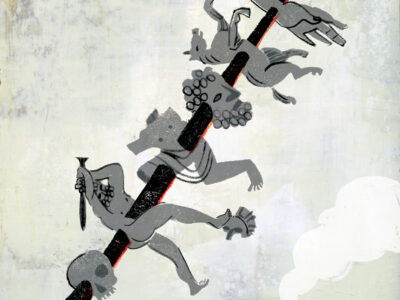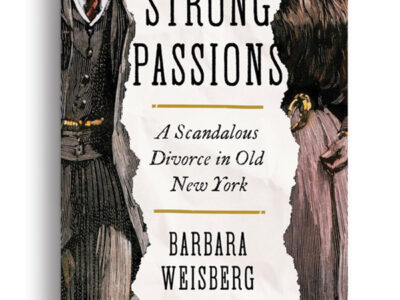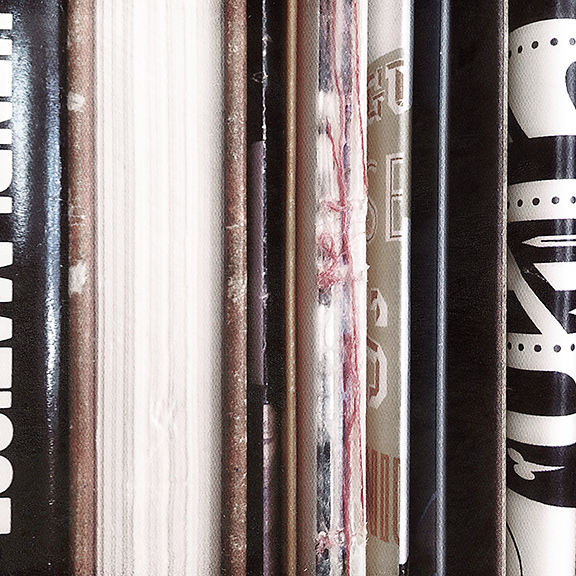
Five Penn authors offer challenges and inspiration to readers seeking better self-control, wiser conversations, age-appropriate outfits, meaningful reading, and wholesome eating.
By Susan Frith
Illustrations by Jay Bevenour

Daniel Akst C’78 will be the first to admit that he suffers from a case of moderation that borders on, well, boring. “I don’t seem to be addicted to anything,” says the journalist, who lives in New York’s Hudson Valley and has been married to his dentist for 18 years. “I’m not a person who is up to my eyeballs in debt or who weighs 400 pounds or is gambling away my kids’ college money.” At one point, Akst quips, he drank too little, but even that habit no longer dogs him. In some of his weaker hours, at least, he avoids writing deadlines by scouting the Internet for tech bargains.
Akst’s relative temperance gives him a safe perch from which to comment on the array of temptations that call to us now that we’re no longer spearing mastodons for our daily survival. With all our free time and choices, modern humans have managed to rack up staggering credit card debt, pack on the pounds, abuse assorted drugs, and engage in a range of self-destructive habits. (That’s not even counting all the hours lost plowing virtual fields on FarmVille.) Akst surveys the damage and dangles some antidotes in his latest book, We Have Met the Enemy: Self Control in an Age of Excess.
Akst became something of an expert on overindulgence while writing his second novel, St. Burl’s Obituary, about a newspaper obituary writer of supersized proportions who undergoes stomach-reduction surgery. When the novel came out in 1996, bariatric procedures were rare, Akst says. “Today, there are something like 200,000 of these operations a year.” To the author, such statistics show “just how hard it can be to control ourselves in a world that appeals ever more effectively to our desires—even if these happen to be desires we’d prefer not to indulge.”
Akst’s latest work joins a host of recent books by Penn alumni pointing to the things we should do with our lives: exercise self-control, adjust our wardrobes as we age, become better acquainted with the food we eat, focus enough on a book to be transformed by it, and converse better with our coworkers. For those inclined to make New Year’s resolutions, this reading collection offers some thought-provoking choices.
Resolution 1. Resist temptation (most of the time).
Our lapses in self-control do more than serve up titillating headlines. (Chances are, you can think of at least one womanizing ex-governor or pro golfer). They also come with wide-ranging consequences, Akst says, citing the annual death toll from cigarette smoking as well as the many lives overturned by the recent financial crisis:
This was the people’s crash, and with our swollen homes and credit card balances, our $4 coffees and gas-guzzling SUVs on lease, nearly all of us took part. Reckless overspending, once limited to the rich, was now a course open to practically every American, just like reckless investing. Suddenly we were all Emma Bovary, bored, entitled, and aghast when the piper at last demanded to be paid.
What saves this book from hand-wringing is the author’s in-depth exploration of self-control, as seen by Greek philosophers, fictional characters from Frog and Toad to Shakespeare’s Tarquin, and many labs full of psychologists and neuroscientists.
Before the wills of nursery-school students were tested with marshmallows, and before undergrads were asked to weigh offers of fast cash or bigger, delayed rewards while reclining in MRI scanners, the Greeks considered the importance of self-control. Aristotle, for example, stressed moderation—avoiding excessive pursuit of pleasure as well as denial—as the key to achieving a meaningful happiness. Plato held up sophrosyne, or self-discipline, as one of the four virtues of citizenship.
That doesn’t mean it has ever come easily. “The self did not evolve to exert the amount of control that we require of it in modern life,” psychologist Mark Leary says. Akst walks us through a brief history of the brain, explaining that our prefrontal cortex allows us to do things like put off pleasure in pursuit of a future goal, but it “is no match for the massively parallel capabilities of the much older parts of the brain, which coordinate a symphony of organic processes without conscious intervention.”
Philosopher Derek Parfit has suggested that some of what we’re up against is a sense of alienation from our “future selves.” Akst floats the analogy of a series of messy guests checking into a hotel room with no cleaning staff. If no one has an incentive to clean the room for the next inhabitant, the place will soon start to reek. “Yet it is foolish to pretend our ‘selves’ are really of so little consequence to one another,” Akst writes. “We know we will become them, and they have a claim on us.”
For many, that future claim is outweighed by present pleasure. Akst looks skeptically at a widening circle of behaviors that society has deemed addictive, from compulsive shopping to overeating to gambling. “There are good grounds for regarding addiction as just an unusually durable form of desire,” he writes. He reaches that conclusion because of how effective incentives and disincentives seem to be in stopping addiction.
Asked to clarify his ideas, Akst argues that the term addiction should be reserved for “that hardcore group of people unable to alter their catastrophic behavior in the face of all incentives to the contrary, and to the point their lives are ruined or even lost. I think the idea that you’re addicted to your ex or to Godiva chocolates is a metaphor that hasn’t served us very well.”
But his book is not about telling readers “to be pious and chaste and virtuous and abstemious at the table,” Akst adds. “What I’m trying to address is why it’s so difficult to act in accord with our own higher wishes.” Our environment plays a huge role.
Concluding that humans ultimately do have self-control, however, Akst devotes the last section of his book to some ways we might flex it. One is to enlist the help of government. Akst thinks this can be done without violating freedoms. Some states, for example, let problem gamblers register, voluntarily, for programs designed to keep them out of the casinos; such self-exclusion programs could be expanded. The government can also educate citizens about better choices and provide incentives for implementing them.
The private sector offers tools as well, Akst writes. Through Stickk.com, people can set personal goals, such as losing 20 pounds or finally finishing that novel, and sign binding contracts to forfeit a certain amount of money if they fail to follow through. Lost funds go to the user’s charity of choice, unless that person has dared to pre-select an “anti-charity” as added motivation. (Think of the political cause you love to hate.) Even without a formal agreement, announcing your intentions to other people can be highly motivating, Akst says.
Probably the most effective strategy, he says, is to manage your environment: Remove temptations from your midst. Turn off your email. Don’t shop for groceries with a rumbling stomach. Stash your credit cards out of reach.
According to Akst, the early Greeks were wise enough to realize the limits of willpower alone. When Odysseus fears he’ll be fatally tempted by the sirens, he has his men fill their ears with beeswax and tie him to the ship’s mast ahead of time; this way, when he feels compelled to follow the deadly music, he can’t.
Resolution 2: Read more deeply. (Tweets don’t count.)
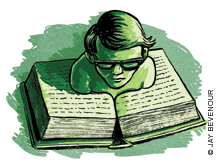
Of course, learning from Odysseus requires an investment in reading time. To focus deeply on any story, for that matter, we need “a certain kind of silence, an ability to filter out the noise,” writes Los Angeles Times book critic David Ulin C’84. In The Lost Art of Reading: Why Books Matter in a Distracted Time, he examines the “noise,” in the form of snarky blogs and vapid news updates, and reflects on the books that have influenced him as a child, a young man, and a maturing time-traveler.
Ulin’s book opens with his own teenage son, Noah, as he rails against having to annotate his reading of The Great Gatsby for a class assignment and utters words that must provoke any adult who has made a living and a life from reading books: “This is why reading is over. None of my friends likes it. Nobody wants to do it anymore.”
Ulin wonders if Noah might be right. Lately he’s noticed his attention wandering when he sits down with the printed page; he attributes this to the lure of email and the Internet, the distraction of the 24-hour news cycle, and “the sense that there is something out there that merits my attention, when in fact it’s mostly just a series of disconnected riffs, quick takes and fragments, that add up to the anxiety of the age.”
The anonymous comments threads on so many websites, which amount to “little more than a collection of parallel monologues,” only add to the chaos. Some are “intelligent and cogent comments,” Ulin concedes; others are “written in a patois barely approximating English, fulminating, outraged, like small embryos of hate.”
One way Ulin shuts out the noise is through the structure of his book, which lacks the typical chapter breaks and instead takes the reader on a winding stroll through his own literary memories, such as filming an adaptation of Kafka’s Metamorphosis with his Penn classmates.
We see Ulin, the teenager, escaping the “brittle clannic gossip” of family holiday gatherings with his head in a book. We get a peek at Ulin, the Penn graduate, scouring bookstalls across Europe for works from writers like Scottish novelist Alexander Trocchi, whose brand of existentialism apparently made Camus look sunny.
Even if today he’s never far from his BlackBerry, Ulin clearly has not lost a sense of why books matter. Writers and readers “take language and put it through a personal metamorphosis, reacting to it, reinventing it, making it our own,” he writes. “The best books are those most open to such a process, the ones that seem to grow along with us, allowing us to inhabit them in different ways at different times.”
Despite Ulin’s critique of the “noise,” this is not a manifesto against the computer age. For example, he heartily endorses one Facebook page, “I Attend Jay Gatsby’s Parties,” where thousands of users around the world have responded to Fitzgerald’s classic by posting comics, photos, videos, and comments. At this party, there are many conversations, but all the guests interact with the same text to create a meaningful whole. One wonders what the conversations would be like if more of these parties were thrown.
So what happens when long-form reading escapes the bounds of the printed book? Ulin expresses some concerns about the proliferation of electronic readers, which potentially “privatizes the most public acts of reading.” If your reading material consists solely of what you’re able to download (with single-user rights) on your Kindle or iPad, you can’t share your favorite book with a friend, nor can anyone “come into your house and peruse your shelves,” he writes.
Despite his preference for the physical text, Ulin makes room for e-readers. He writes, “I can’t help but feel hopeful about the buzz these devices generate, all those people reading books on screen.”
What matters, after all, is the connection made with another, whether through pages turned or bytes digested. “Reading is … perhaps the only act in which we allow ourselves to merge with the consciousness of another human being,” Ulin writes. “We possess the books we read, animating the waiting stillness of their language, but they possess us also, filling us with thoughts and observations, asking us to make them part of ourselves.”
Resolution 3: Dress for your current life.

Like the books we read, our clothing choices also play a role in shaping how we evolve as we age. In What to Wear for the Rest of Your Life: Ageless Secrets of Style, style guru Kim Johnson Gross CW’74 addresses the woman who has accumulated years of experience and perhaps also a closet full of outfits that no longer fit her complexion, shape, or lifestyle.
Gross, a former Ford model and fashion editor who co-created the Chic Simple book series in the 1990s, found herself in this situation at age 50, when she discovered “the Alien” on her belly. This deposit of abdominal fat happened to coincide with other life changes, including divorce and the close of her business.
“The infallible self-image that I had held for so long was of an attractive, youthful, strong, energetic woman who would always be the tall, slim one in the crowd,” she writes. All of this changed “when an elegant older woman in tai chi class commented on how gracefully I moved considering I was pregnant.” All of a sudden, “The closet that had been a safe haven was elevated to code red.”
While Gross comes to accept her new shape, she also realizes it’s time for a fresh start. She takes steps to make sure she is as healthy as possible, inside and out, and analyzes her wardrobe. Gross personalizes this style guide with her own predicaments, such as having to pick out the best outfit in which to meet her ex’s “next,” while guiding her readers to put together their own “feel-good” closets.
She also shares the wisdom of other women, including one 50-something who, after being diagnosed with breast cancer, always dressed her best for appointments with her oncologist. “I wanted the doctor to get the message that I was going to live.”
Gross downplays fashion fads while focusing on some unchanging style rules, such as “achieve visual balance” and “use color to your advantage.” With a nod to the downsized economy, she suggests that readers first “shop” their own closets to find clothes that fit well and inspire confidence.
Her overall tone is optimistic, encouraging, and sisterly, though at times her advice can seem a little proscriptive. In one series of fashion prompts, Gross writes that “Age appropriate is turning your favorite mini skirts into pillows, regardless of how great your legs are.”
Mostly, though, Gross works in compromises, advising readers who can’t quite button their pants to “wear a top long enough to hide the unmentionable” and suggesting accessories like an eye-catching necklace to draw attention away from an aging neck.
She also recognizes that letting go, while necessary, can be hard. Gross admits that she’s hung on to a few outgrown outfits (including an impractical micro-mini) because of the memories they hold, even as she makes room in her closet for her next adventures.

Resolution 4: Have 12 conversations (just not at one time).
Just as your wardrobe reveals much about you, so can the way you talk to your boss, your coworkers, and your employees. It can also affect whether you come into the office with dread or joy in your heart, writes Shawn Kent Hayashi G’94 in Conversations for Change: 12 Ways to Say it Right When It Matters Most.
Good communication starts from within, she adds. “With self-awareness, we can change our inner conversations about what we are feeling and create different outcomes in conversations with others.”
Hayashi presents 12 kinds of conversations that we should all learn to have, from a Conversation for Accountability to a Conversation for Breakdown. If one of these dialogues is missing from your toolkit, it could be holding you back, she argues.
A Conversation for Connection, for example, can help you fit into your workplace, create new relationships, inspire change, and earn the loyalty of your team. To start one, Hayashi urges readers to focus on the current moment, use sustained eye contact, and listen closely to their conversation partner.
She gives the example of Jean and Bob, two bank supervisors whose departments weren’t getting along until Jean asked Bob to meet for coffee. As she listened to his concerns, Jean gained insights into Bob’s motivations and communication style; she also learned that he liked to make decisions slowly. Then, after Jean shared her views, she suggested that they take some time to think about the issue. When the two, better-acquainted supervisors got back together, both were eager to reach a solution.
Hayashi’s Conversation for Creating New Possibilities begins with brainstorming. She challenges the reader to think of “100 opportunities, things, experiences, conversations, companies you’d like to work with, or assignments you want.” If you can’t think of that many, she writes, you “may be creating your own glass ceiling, limiting what you believe is possible for you.” In this case, a trusted supervisor or coworker can ask questions to help you uncover new ideas.
Hayashi works through each of these conversation types in straightforward, earnest prose, offering examples of dialogue that at times seem a bit wooden. For example, one suggested conversation starter for Conflict Resolution is: “I have a commitment to focus on the desired behavior and outcomes we’d like to create rather than focus on what we don’t want. Will you join me in this?”
What Hayashi’s conversations may lack in natural flow, they sometimes make up for in moxie. Using a Conversation for Action, one manager dealt with an employee who always smelled of body odor after playing tennis during his lunch break. She presented a bottle of deodorant and asked, point blank, if there was any medical reason that he couldn’t use it. There wasn’t. Things starting smelling better after that.
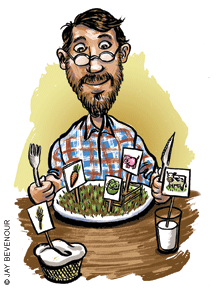
Resolution 5: Eat good food with funny names.
To know your colleagues may require a few conversations. To truly learn about where your food comes from takes some digging—in the dirt—as writer Melanie Rehak C’93 finds out in Eating for Beginners: An Education in the Pleasures of Food from Chefs, Farmers, and One Picky Kid.
Rehak had always loved to cook, and after reading books like Fast Food Nation and The Omnivore’s Dilemma, she was determined to develop more sustainable eating habits. But it was hard to know how to put them into practice for herself and her family. Rehak found herself weighing one priority against another: Better to be organic? Or grass-fed? Harvested sustainably or close to market? Complicating matters was Jules, her picky one-year-old. Forget about free-range chicken; he scorned even pasta and toast.
That’s how Rehak ends up working at applewood, a small Brooklyn restaurant devoted to local farming, and visiting the farmers, cheese makers, and fishermen who stocked its kitchen. She crawls through the dirt to pick potatoes, butchers goats, and takes a stomach-tossing ride on a fishing boat. “If I was really going to learn about food, if I was going to understand the choices and compromises for myself and be able to make them with confidence, I wanted to learn about it from, quite literally, the ground up,” Rehak writes.
This is no Kitchen Confidential. Unlike the cocky, cursing chefs who populate Anthony Bourdain’s memoir about the restaurant industry, applewood’s staff is civil, and unbelievably patient with the panicked novice in their midst.
This doesn’t mean that Rehak’s education is entirely pain-free. At one point, overwhelmed by sizzling frying pans, boiling pots, and “a huge line-up of fish on the counter waiting to be cooked,” she asks applewood’s co-owner, David Shea, if the halibut should come off the stove yet. “‘What do you think?’ he asked calmly, as though we were not surrounded by fire and sweat and there were no hungry people on the other side of the glass-paned door. ‘I don’t know!’ I shrieked. ‘I’m a writer!’” Then Rehak singes the hair on her arm reaching for the back burner.
Finger-wagging is another ingredient absent from this book. Despite their commitment to serving locally grown food, the restaurant’s owners are pragmatists. That is why salad greens from Florida turn up on applewood’s winter menu; otherwise, David explains, there would be nothing to serve but rutabagas. Even the restaurant’s conscientious suppliers admit to dining on fast food occasionally. (Much to Rehak’s relief, it also turns out that the kids of organic farmers have to be bribed to eat their vegetables sometimes.)
If the people in Rehak’s book are relatively mild-mannered, the food comes across a bit feistier. We are introduced to cheese that smells like body odor, goats that pee on their beards as an aphrodisiac, and a squash called “Thelma Sanders, which sounded more like the name of a third-grade teacher than a squash to me.”
Rehak’s colorful descriptions alone are reason enough to protect our food supply, showing off its quirky diversity. She even manages, between bouts of vomiting on that fishing boat 50 miles from shore, to observe the day’s catch in detail: “The monkfish’s huge head, as wide as the whole fish was long, was all mouth. Its interior, used to catch and hold prey as big as the fish itself, was clean and fresh looking and arched at the top like a miniature cathedral ceiling.”
While cooking burns and seasickness add authenticity to her culinary odyssey, Rehak concludes early on in her book that balance is the answer to many of the questions she began with:
After you’ve been digging in a potato field and eaten eggs from the hen house next to the farmhouse you’re sitting in, food seems, if only temporarily, very simple; so does supporting people who grow it carefully. And supporting them didn’t mean I had to forego the occasional bag of non-local carrots, which I bought when I had to because carrots were one of the few things Jules would eat. It meant making the right choice as often as possible and accepting that that was all any of us could do.
The right choice as often as possible. As New Year’s resolutions go, this might just be one that many of us can keep.
Freelance writer and former Gazette associate editor Susan Frith last wrote the Sept|Oct cover story on writer-mom and autism activist Susan Senator C’84 G’85.


